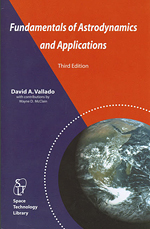|
|
|
Fundamentals of Astrodynamics and Applications (3rd Edition) [David Vallado- 2007] (softcover)
Buy Product Online | Visit Store Home |
|
|
|
||
|
Other Items from >Astrodynamics and Aerodynamics
|
||
| Return To Microcosm Astronautics Books and Software | ||
|
|
||
|
|
||
| E-commerce powered by MonsterCommerce shopping cart software. |

